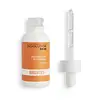What's inside
What's inside
 Key Ingredients
Key Ingredients

 Benefits
Benefits

 Concerns
Concerns

 Ingredients Side-by-side
Ingredients Side-by-side

Water
Skin ConditioningPropanediol
SolventGlycerin
HumectantButylene Glycol
HumectantPhenoxyethanol
PreservativeXanthan Gum
EmulsifyingMannitol
HumectantPhosphatidylcholine
EmulsifyingEthylhexylglycerin
Skin ConditioningResveratrol
AntioxidantPolyglyceryl-10 Laurate
Skin ConditioningCetyl Alcohol
EmollientPotassium Sorbate
PreservativeSodium Benzoate
MaskingTocopheryl Acetate
AntioxidantSodium Chloride
MaskingWater
Skin ConditioningGlycerin
HumectantButyrospermum Parkii Butter
Skin ConditioningCetyl Alcohol
EmollientTocopheryl Acetate
AntioxidantPanthenol
Skin ConditioningPhenoxyethanol
PreservativeHydrogenated Vegetable Glycerides
EmollientPrunus Amygdalus Dulcis Oil
Skin ConditioningPotassium Cetyl Phosphate
EmulsifyingButylene Glycol
HumectantHydrogenated Palm Glycerides
EmollientXanthan Gum
EmulsifyingMicrocrystalline Cellulose
AbsorbentAllantoin
Skin ConditioningEthylhexylglycerin
Skin ConditioningJuglans Regia Leaf Extract
AbrasiveJuglans Regia Shell Extract
Skin ConditioningCentella Asiatica Extract
CleansingLecithin
EmollientPyrus Germanica Extract
Skin ConditioningHelianthus Annuus Seed Oil
EmollientTocopherol
AntioxidantCellulose Gum
Emulsion StabilisingCitric Acid
BufferingBiosaccharide Gum-1
HumectantPotassium Sorbate
PreservativePantolactone
HumectantLeontopodium Alpinum Flower/Leaf Extract
Skin ConditioningSorbic Acid
PreservativeWater, Glycerin, Butyrospermum Parkii Butter, Cetyl Alcohol, Tocopheryl Acetate, Panthenol, Phenoxyethanol, Hydrogenated Vegetable Glycerides, Prunus Amygdalus Dulcis Oil, Potassium Cetyl Phosphate, Butylene Glycol, Hydrogenated Palm Glycerides, Xanthan Gum, Microcrystalline Cellulose, Allantoin, Ethylhexylglycerin, Juglans Regia Leaf Extract, Juglans Regia Shell Extract, Centella Asiatica Extract, Lecithin, Pyrus Germanica Extract, Helianthus Annuus Seed Oil, Tocopherol, Cellulose Gum, Citric Acid, Biosaccharide Gum-1, Potassium Sorbate, Pantolactone, Leontopodium Alpinum Flower/Leaf Extract, Sorbic Acid
Ingredients Explained
These ingredients are found in both products.
Ingredients higher up in an ingredient list are typically present in a larger amount.
Butylene Glycol (or BG) is used within cosmetic products for a few different reasons:
Overall, Butylene Glycol is a safe and well-rounded ingredient that works well with other ingredients.
Though this ingredient works well with most skin types, some people with sensitive skin may experience a reaction such as allergic rashes, closed comedones, or itchiness.
Learn more about Butylene GlycolCetyl Alcohol is a fatty alcohol. Fatty Alcohols are most often used as an emollient or to thicken a product.
Its main roles are:
Though it has "alcohol" in the name, it is not related to denatured alcohol or ethyl alcohol.
The FDA allows products labeled "alcohol-free" to have fatty alcohols.
Learn more about Cetyl AlcoholEthylhexylglycerin (we can't pronounce this either) is commonly used as a preservative and skin softener. It is derived from glyceryl.
You might see Ethylhexylglycerin often paired with other preservatives such as phenoxyethanol. Ethylhexylglycerin has been found to increase the effectiveness of these other preservatives.
Glycerin is already naturally found in your skin. It helps moisturize and protect your skin.
A study from 2016 found glycerin to be more effective as a humectant than AHAs and hyaluronic acid.
As a humectant, it helps the skin stay hydrated by pulling moisture to your skin. The low molecular weight of glycerin allows it to pull moisture into the deeper layers of your skin.
Hydrated skin improves your skin barrier; Your skin barrier helps protect against irritants and bacteria.
Glycerin has also been found to have antimicrobial and antiviral properties. Due to these properties, glycerin is often used in wound and burn treatments.
In cosmetics, glycerin is usually derived from plants such as soybean or palm. However, it can also be sourced from animals, such as tallow or animal fat.
This ingredient is organic, colorless, odorless, and non-toxic.
Glycerin is the name for this ingredient in American English. British English uses Glycerol/Glycerine.
Learn more about GlycerinPhenoxyethanol is a preservative that has germicide, antimicrobial, and aromatic properties. Studies show that phenoxyethanol can prevent microbial growth. By itself, it has a scent that is similar to that of a rose.
It's often used in formulations along with Caprylyl Glycol to preserve the shelf life of products.
Potassium Sorbate is a preservative used to prevent yeast and mold in products. It is commonly found in both cosmetic and food products.
This ingredient comes from potassium salt derived from sorbic acid. Sorbic acid is a natural antibiotic and effective against fungus.
Both potassium sorbate and sorbic acid can be found in baked goods, cheeses, dried meats, dried fruit, ice cream, pickles, wine, yogurt, and more.
You'll often find this ingredient used with other preservatives.
Learn more about Potassium SorbateTocopheryl Acetate is AKA Vitamin E. It is an antioxidant and protects your skin from free radicals. Free radicals damage the skin by breaking down collagen.
One study found using Tocopheryl Acetate with Vitamin C decreased the number of sunburned cells.
Tocopheryl Acetate is commonly found in both skincare and dietary supplements.
Learn more about Tocopheryl AcetateWater. It's the most common cosmetic ingredient of all. You'll usually see it at the top of ingredient lists, meaning that it makes up the largest part of the product.
So why is it so popular? Water most often acts as a solvent - this means that it helps dissolve other ingredients into the formulation.
You'll also recognize water as that liquid we all need to stay alive. If you see this, drink a glass of water. Stay hydrated!
Learn more about WaterXanthan gum is used as a stabilizer and thickener within cosmetic products. It helps give products a sticky, thick feeling - preventing them from being too runny.
On the technical side of things, xanthan gum is a polysaccharide - a combination consisting of multiple sugar molecules bonded together.
Xanthan gum is a pretty common and great ingredient. It is a natural, non-toxic, non-irritating ingredient that is also commonly used in food products.
Learn more about Xanthan Gum